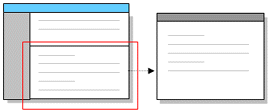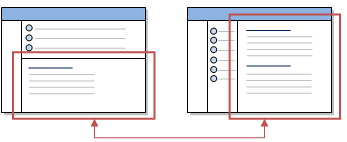Customize the source display
When you open a source in Detail View you can customize the display to suit the way you work.
What do you want to do?
- Display the source in a separate window
- Display the source on the right
- Show tabs for annotations, 'see also' links and relationships
- Highlight what has been coded
- Display Coding Stripes
- Zoom in on source content
- Show, hide or move the Quick Coding bar
- Hide the bookmarks pane in PDF sources
- Switch to page layout view in documents, externals and memos
Display the source in a separate window
You can undock Detail View to work with your source in a separate window:

-
Open a source.
-
On the View tab, in the Window group, clear the Docked check box.
NOTE You can select Undock All if you have multiple sources open in Detail View.
Display the source on the right
You can arrange your NVivo workspace to display your source on the right side of the window. This can be useful when you use drag and drop coding—refer to Coding techniques for more information.

On the View tab, in the Workspace group, click Detail View, and then click Right.
Show tabs for annotations, 'see also' links and relationships
You can show the annotations, 'see also' links and relationships that have been defined for the source. They are displayed in tabs at the bottom of the NVivo window:
-
Open a source in Detail View.
-
Do one of the following:
-
On the View tab, in the Window group, select the Annotations check box.
-
(NVivo Pro and Plus only) On the View tab, in the Links group, select the Annotations, See Also Links and Relationships check boxes.
If you want to display these tabs by default when you open a source or a node—refer to Set application options (Display tab options).
Highlight what has been coded
You can 'turn on' highlighting to see what has been coded in a source:
To highlight the coding in a source:
-
Open a source.
-
On the View tab, in the Coding group, click Highlight, and then click a highlight option.

Refer to Highlight coding references for more information.
Display Coding Stripes
Coding stripes are colored bars that let you see the coding for a source. You can select all nodes, specific nodes or display the nodes that most, least or recently code the content. You can also show coding stripes for the users who coded the content or show coding stripes for case attribute values.
-
Open a source.
-
On the View tab, in the Coding group, click Coding Stripes, and then click a coding stripe option.

Refer to Use coding stripes to explore coding for more information.
Zoom in on source content
You can zoom in on a source to get a close-up of the content or to see more of the source at a reduced size.
-
Open a source.
-
On the View tab, in the Zoom group, click the arrow beside Zoom, and then click a zoom option.

Show, hide or move the Quick Coding bar
The Quick Coding bar is displayed by default when you open a source or node in Detail View. You can hide or move the Quick Coding bar—refer to Customize the workspace for more information.
Hide the bookmarks pane in PDF sources
When a PDF contains bookmarks, by default, the bookmarks are displayed in a pane on the left side of Detail View. Bookmarks allow you to navigate to a particular section of the PDF—for example, go to the appendices. When a PDF does not contain bookmarks, the bookmarks pane is not displayed.
To hide the bookmarks pane:
-
On the View tab, in the Windows group, clear the Bookmarks check box,
The bookmarks are hidden for the PDF source you are currently viewing.
Switch to page layout view in documents, externals and memos
By default, documents, externals and memos are displayed in normal view and page boundaries are not visible. If you prefer to see the document, external or memo as a series of pages, you can switch to page layout view.
To switch to page layout view:
-
On the View tab, in the Window group, click Layout, and then click Page Layout.



